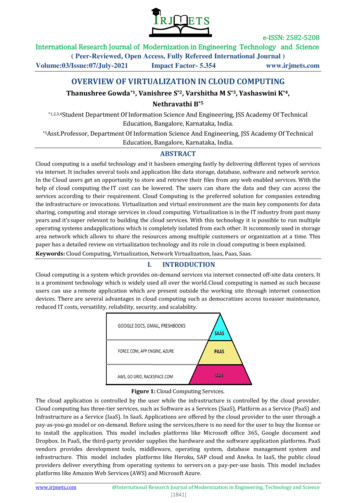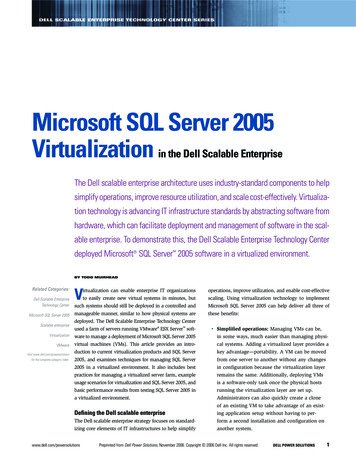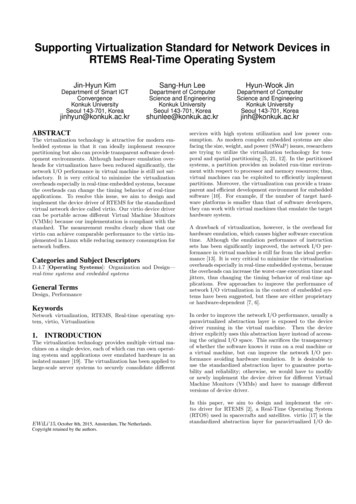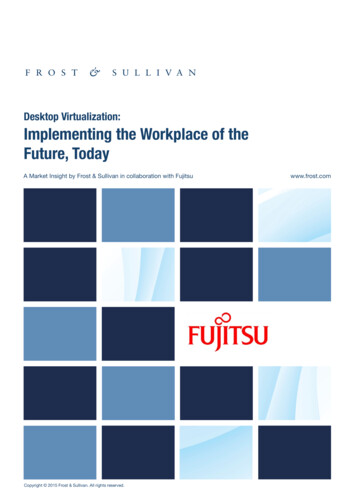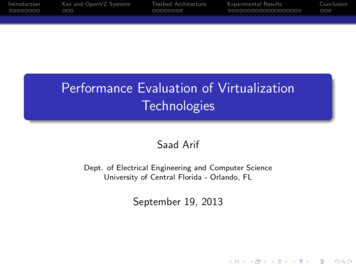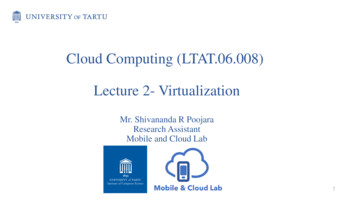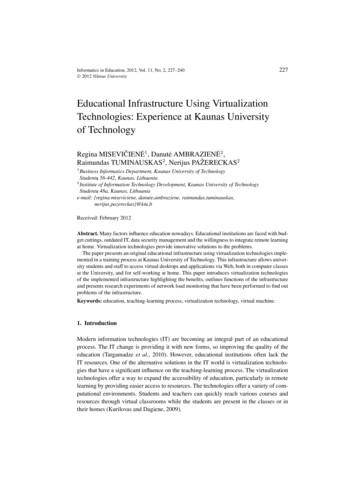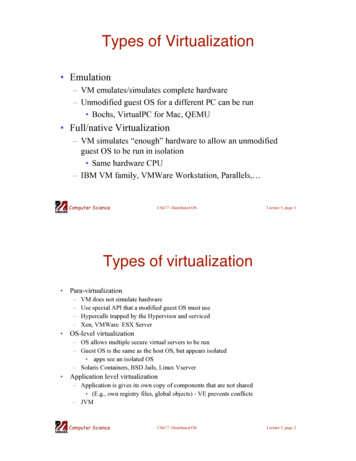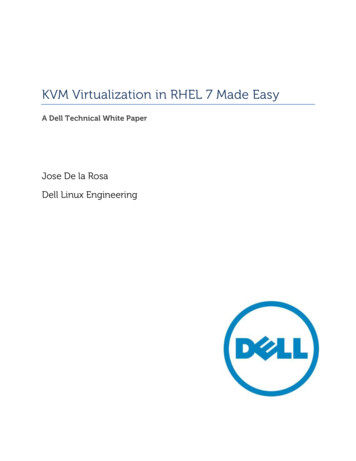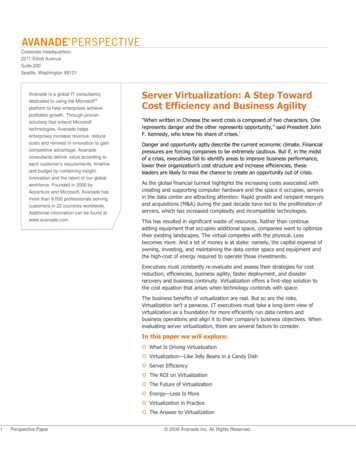
Transcription
1Corporate headquarters:2211 Elliott AvenueSuite 200Seattle, Washington 98121Avanade is a global IT consultancydedicated to using the Microsoft platform to help enterprises achieveprofitable growth. Through provensolutions that extend Microsofttechnologies, Avanade helpsenterprises increase revenue, reducecosts and reinvest in innovation to gaincompetitive advantage. Avanadeconsultants deliver value according toeach customer’s requirements, timelineand budget by combining insight,innovation and the talent of our globalworkforce. Founded in 2000 byAccenture and Microsoft, Avanade hasmore than 9,000 professionals servingcustomers in 22 countries worldwide.Additional information can be found atwww.avanade.com.Server Virtualization: A Step TowardCost Efficiency and Business Agility―When written in Chinese the word crisis is composed of two characters. Onerepresents danger and the other represents opportunity,‖ said President JohnF. Kennedy, who knew his share of crises.iDanger and opportunity aptly describe the current economic climate. Financialpressures are forcing companies to be extremely cautious. But if, in the midstof a crisis, executives fail to identify areas to improve business performance,lower their organization’s cost structure and increase efficiencies, theseleaders are likely to miss the chance to create an opportunity out of crisis.As the global financial turmoil highlights the increasing costs associated withcreating and supporting computer hardware and the space it occupies, serversin the data center are attracting attention. Rapid growth and rampant mergersand acquisitions (M&A) during the past decade have led to the proliferation ofservers, which has increased complexity and incompatible technologies.This has resulted in significant waste of resources. Rather than continueadding equipment that occupies additional space, companies want to optimizetheir existing landscapes. The virtual competes with the physical. Lessbecomes more. And a lot of money is at stake: namely, the capital expense ofowning, investing, and maintaining the data center space and equipment andthe high-cost of energy required to operate those investments.Executives must constantly re-evaluate and assess their strategies for costreduction, efficiencies, business agility, faster deployment, and disasterrecovery and business continuity. Virtualization offers a first-step solution tothe cost equation that arises when technology contends with space.The business benefits of virtualization are real. But so are the risks.Virtualization isn’t a panacea. IT executives must take a long-term view ofvirtualization as a foundation for more efficiently run data centers andbusiness operations and align it to their company’s business objectives. Whenevaluating server virtualization, there are several factors to consider.In this paper we will explore:What Is Driving VirtualizationVirtualization—Like Jelly Beans in a Candy DishServer EfficiencyThe ROI on VirtualizationThe Future of VirtualizationEnergy—Less Is MoreVirtualization in PracticeThe Answer to VirtualizationPerspective Paper 2009 Avanade Inc. All Rights Reserved.
2Corporate headquarters:2211 Elliott AvenueSuite 200Seattle, Washington 98121What Is Driving VirtualizationHigh growth and ―irrational exuberance‖ quickly come to mind when defining business in the late 1990s.Consolidation within industries certainly ranks as a possible definition of the business landscape as we nearthe end of the first decade of the 21st century.But whether companies experienced rapid growth or found themselves on the buying or selling end of anM&A transaction, they added IT systems. They patched existing systems together to keep operationsfunctioning and business moving. Unfortunately, that led to duplicate, incompatible and legacy systems. Allof this has led to widespread inefficiencies, skyrocketing costs, complexity and inflexibility, to name a fewchallenges.In the midst of IT adding and patching systems, global competition forced management to look for ways toreduce costs and complexity while maintaining or increasing service levels. Executives sought to make theirbusinesses more nimble. They wanted to respond tofast-changing global conditions. They sought to becomemore efficient to better compete with competitors, lowercosts and improve shareholder value.Gartner notes that “virtualizationThe proliferation of multiple system platforms, oftenresulting from mergers and acquisitions and the lack ofan overall IT strategy, leads to challenges in respondingto business demands. IT executives must deal withinfrastructures that are complex and often disconnected.What follows are extra administrative, utility, facilitiesand management costs, and escalating requirements fordata center space, as well as service and maintenance issues.is the highest-impact issuechanging infrastructure andoperations through 2012 ”Typically when this happens, a company’s technology infrastructure costs slip out of control. Servervirtualization can become a compelling approach to getting control over server infrastructures.Divergent paths–complex and costly IT systems colliding with business requirements for efficiency andagility–created an environment ripe for virtualization.Virtualization—Like Jelly Beans in a Candy DishVirtualization is relatively simple in concept. In describing how it works, Steve Fink, Avanade SolutionArchitect, compares it to a candy dish filled with jelly beans. Think of the dish as server hardware and thejelly beans as representing the operating system. If you only have one jelly bean in the dish, it’s not beingused as effectively as it could. If you add more jelly beans, the dish space is used more effectively. That’sbasically what virtualization involves–optimizing a hardware resource.Essentially, server virtualization helps maximize hardware use by aggregating more applications and servicesonto fewer pieces of hardware, while maintaining operating system separation. So server virtualizationenables applications and services to safely coexist on the same server hardware, yet within multipleoperating systems.The virtualization process poses challenges, however. IT must understand what the operational processrequires to move from many physical servers to fewer physical servers. Where a one-to-one relationshiponce existed between a server and its operating system, now a company might have a many-to-onerelationship of operating systems to server hardware platforms. If not managed correctly, that can createchallenges in IT operations and service delivery.Perspective Paper 2009 Avanade Inc. All Rights Reserved.
Server Virtualization 2009Avanade believes that a standardized set of operational processes can be applied to IT management to dealwith the changes needed. But it does require companies to change the way they think about their servers,and how they use them.Server EfficiencyThe primary sales message for advocating virtualization is that companies are leaving money on the table–ahigh percentage of servers are woefully underused. Statistics on server utilization, as measured by CPUutilization percentage, differ depending on the source. Server utilization ranges anywhere from 5 percent to40 percent. Avanade and independent industry surveys estimate that server utilization rates of 20 percent orless are more common. It warrants stating the obvious–tremendous inefficiency through excess capacityexists in data centers.One Gartner report found that ―even underutilized servers use high amounts of energy. Increasingutilization levels to 60% and more requires only modest increases in power. The effective use ofiivirtualization can reduce server energy consumption by up to 82% and floor space by 85%‖ . Servervirtualization can improve the use of many resources that companies already have invested in foradministration, facilities, and hardware.The ROI on VirtualizationIn order for businesses to know if virtualization will help meet their financial goals, it’s important to conducta financial analysis to determine a company’s server landscape total cost of ownership. Avanade created amodeling tool that calculates and compares virtualization costs, so clients can gain a detailed picture thatcan help them decide if, in fact, virtualization makes financial sense. The Avanade Virtualization BusinessCase Estimator (Figure 1) helps quantify the impact of server virtualization on cost savings, energyconsumption, IT staffing, carbon footprint, and systems maintenance.Figure 1In the model, Avanade uses as many as 150 input variables that are analyzed to determine the financialimpact of moving to a virtualized data center. That leads to a calculations matrix that can show clients theshort- and long-term impact of data center virtualization. Clients typically realize short-term benefits whenserver virtualization is integrated into a strategic investment plan.Here are examples of average results garnered with the Avanade Virtualization Business Case Estimator.Figure 2 shows the difference between a non-virtualized server and a virtualized environment when it comesto power costs.3Perspective Paper 2009 Avanade Inc. All Rights Reserved.
Server Virtualization 2009Virtualization Cuts Energy Costs Consumption Nearly 75 PercentFigure 2Figure 3 indicates the cost savings that comes from virtualized guests on a server.Cost Savings RealizedFigure 3When it comes to the return on investment, Figure 4 shows an operating cost savings of 12.06% and areturn on investment of 1.1 years, or 14 months.4Perspective Paper 2009 Avanade Inc. All Rights Reserved.
Server Virtualization 2009Figure 4The Future of VirtualizationThe media coverage today increasingly centers on server, desktop, application and storage as majorsegments of virtualization. Almost 40 percent of respondents had ―virtualized a significant number of serversand services" with an additional 10 percent reporting that they had plans to do so within the next 12months.‖iii Gartner notes that ―virtualization is the highest-impact issue changing infrastructure andoperations through 2012. It will change how you manage, how and what you buy, how you deploy, howivyou plan and how you charge.‖ The worldwide virtualizationmarket will grow to 3.5 billion in 2011, a 27.1% CAGR fromCase Study: National Australia Bank2006, shows an IDC forecast.vNAB is a leading financial services organization withoperations in multiple countries. The geographicEnergy—Less Is Moredistribution of its offices slowed regional applicationBusinesses are under increasing pressure to proactivelydeployment. One of NAB’s goals was to consolidateaddress environmental concerns. While the primary drivers forits IT infrastructure to help meet corporate goalscompanies to consider virtualization are improved businessfor reducing power consumption.agility, speed, and cost benefits, green computing initiativesNAB took advantage of Windows Server 2008deliver a by-product: the benefit of an environmentally soundvirtualization technology to consolidate serverbusiness practice. It can enhance corporate valuations andhardware. NAB partnered with Avanade andreputations for responding to sustainability and complianceMicrosoft to achieve tangible business results–requirements.smaller server footprint (less space), easierOne example of a company that is focused on leveragingtechnology management (higher performance),virtualization as part of a broader environmental and businessand improved energy efficiency (lower costs).commitment is the National Australia Bank (NAB) Group (seeJohn Stewart, chief executive of National Australiasidebar case study).Bank Group, made a commitment that NAB wouldConserving energy becomes increasingly essential in thebe carbon neutral by 2010. The bank estimatedfuture. In fact, as many as half the data centers in the worldthat its IT environment accounted for more thanwill soon face a shortage of cooling needs and energy90 percent of the organization’s total energycapacity to deal with the newest, high-density computerexpenditure. To help the company meet its goal,equipment, some analysts say.NAB hoped to consolidate hardware and reducepower consumption and greenhouse emissions.According to some research, enterprise data centers couldspend as much on energy in the next few years as they do onhardware infrastructure. Some estimates go so far as tosuggest energy bills could soon total more than half of theoverall IT budget.5Perspective PaperTo read more details of how NAB initiated acomprehensive IT initiative to improve businessperformance, please click here. 2009 Avanade Inc. All Rights Reserved.
Server Virtualization 2009Toby Velte, noted author of ―Green IT: Reduce Your Information System’s Environmental Impact WhileAdding to the Bottom Line,‖ outlines the financial and environmental benefits that organizations can gainthrough server virtualization and consolidation. In his book, Velte offers a detailed implementation plan forintegrating environmentally sound techniques and technologies as part of a business-driven green initiative.Velte created a fictional company to show how virtualization and green IT might work. He gave thecompany 1,000 servers and 5,000 desktops with 500 terabytes (TB) of storage. Then he used the AvanadeVirtualization Business Case Estimator to analyze variables involving server information, tool costs, humanresources, licensing costs, financials, power costs, and data center facilities.In this example, the non-virtualized costs per server came to 13, 047 and virtualized costs, 3,795. Thecarbon emission savings were 1,700 tons of carbon emissions per year. In total, the company saved 6.4million a year with a positive return on investment achieved in 14 months.Figure 5 shows how virtualization affects projected KwH and the carbon footprint.Figure 5Figure 6 offers another picture of the carbon footprint.Figure 66Perspective Paper 2009 Avanade Inc. All Rights Reserved.
Server Virtualization 2009And Figure 7 shows an annual power savings of 2.2 million.Ultimately, virtualization works bestwhen companies are open tomodifying their operational processto accommodate increasedenvironment complexities. Ananalysis of many variables canindicate savings that translate into abetter bottom line. Velte believesthat attitude change about IT isessential for virtualization to takeplace. He believes that too many ITmanagers have an unnecessary needto know where their servers are, andthat IT departments must overcometheir knee-jerk tendency to useanother server when they get a newapplication.Figure 7Virtualization in PracticeMicrosoft has made significant investments and inroads in server virtualization. In 2008, Microsoft launchedHyper-V as a key feature of Windows Server 2008. In this fictional case study, Avanade comparedMicrosoft Hyper-V and VMware for Company AZT, which has 1,450 small branch offices. Each branch hasfive servers. The company wants to pursue a virtualization strategy that reduces the number of servers ineach branch by more than half, to two servers. It plans to implement a technology called ―clustering‖ to addsome levels of redundancy.Figure 8 deals with software licensing. Note the substantial savings in comparing Microsoft Hyper-V toVMware.Figure 8In this type of scenario, Avanade typically sees these kinds of cost benefits for Microsoft Hyper-V. Avanadewas an early adopter of Microsoft Hyper-V. Based on our experience and work with clients, we believeMicrosoft Hyper-V is enterprise-ready and a competitive solution to other virtualization offerings on themarket. While Avanade is focused on the Microsoft platform, it has extensive experience working with7Perspective Paper 2009 Avanade Inc. All Rights Reserved.
Server Virtualization 2009clients in heterogeneous environments. Avanade works within a client’s chosen platform and helps themimplement Microsoft solutions alongside other platforms in support of their business and technologyobjectives.The Answer to VirtualizationAvanade provides a portfolio of virtualization solutions designed to help organizations reduce costs, enablebusiness change and increase revenue. It results in more innovation and a greater competitive advantage.Avanade’s approach is to:Take a holistic approach that ensures all dependencies, such as business and IT parameters, areconsidered.Deploy in phases to help reduce costs and keep risk within comfortable parameters.Reuse reliable assets, which can support minimal downtime and minimal impact on users.Ensure fast implementations that use proven assets and techniques that can reduce developmenttimes and speed development.Avanade uses an extensive set of tools, methodologies, and best practices in enterprise technologies to helpits customers implement virtualization solutions. The Avanade Data Center Transformation solutiondelivers a virtualized, automated data center that can provide agility through dynamic business processes.Companies interested in virtualization can tap into the power of Microsoft Hyper-V and System CenterVirtual Machine Manager and leverage key Avanade assets and capabilities, such as the AvanadeVirtualization Business Case Estimator and ACA Dynamic Systems Framework delivery accelerators, toimprove time to scale, help reduce operational costs, and address green computing pressures, for optimalefficiency and rock-solid security.ConclusionThe economic climate is forcing companies to look for every possible means of increasing efficiency,flexibility and cost effectiveness. Strategic companies will capitalize on the current business crisis to createfuture opportunities. Server virtualization offers possibilities in an environment where some organizationsmight be paralyzed with fear.Virtualization involves a long-term strategy. It transforms how a company approaches IT and will require achange in how companies see their computing needs evolving and how they want to address them.Virtualization is the foundation for building an optimized data center that can help companies improveserver efficiency, lower energy costs and enhance IT flexibility.Avanade believes that companies can confront the risks and rewards that come with virtualization in a waythat optimizes their data center in the most efficient and flexible manner. But don’t think of it as a quick fix.Think of it as future fix that can pay off in the long run. And it can pay off because Avanade is committed tohelping companies realize results with virtualization.For more information, please visit www.avanade.com.Note: This perspective paper contains statements that may be related to the future development and direction of Avanade, Inc. Thesestatements may represent only current plans or goals of Avanade as of the date of publication and are subject to change without noticebased on our technical and business judgment. Other company, product and service names mentioned in this document are registeredtrademarks or trademarks of their respective owneriJohn Fitzgerald Kennedy (1917–1963), U.S. presidentSpeech, April 12, 1959, Indianapolisii ―Energy Savings via Virtualization: Green IT on aBudget,‖ Gartner, 11/10/08.iiiInfoWorld, Dave Marshall Virtualization Report, 5/25/08.iv―Virtualization Changes Virtually Everything,‖ Gartner,3/28/08v8InfoWorld, Dave Marshall Virtualization Report, 5/25/08.Perspective Paper 2009 Avanade Inc. All Rights Reserved.
The virtual competes with the physical. Less becomes more. And a lot of money is at stake: namely, the capital expense of . Figure 3 indicates the cost savings that comes from virtualized guests on a server. Cost Savings Realized Figure 3 When it comes to the return on investment, Figure 4 shows an operating cost savings of 12.06% and a
